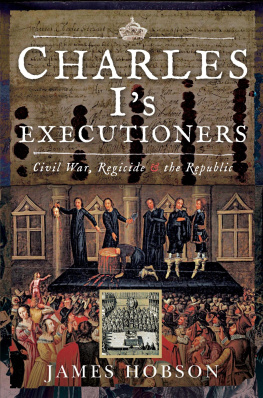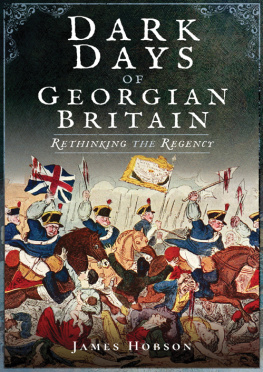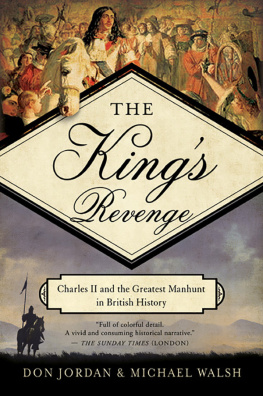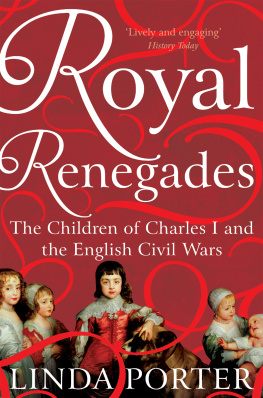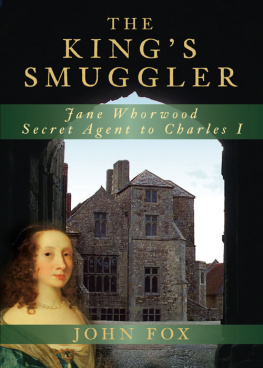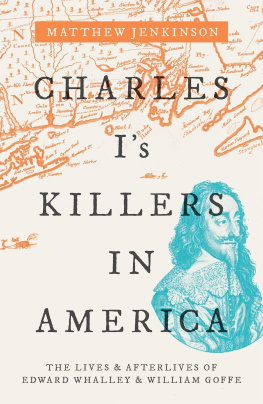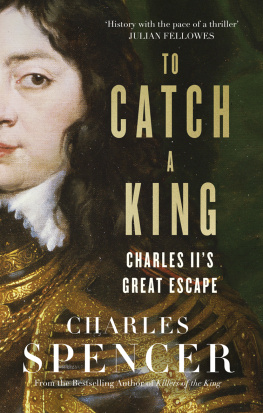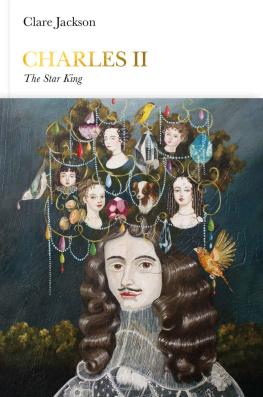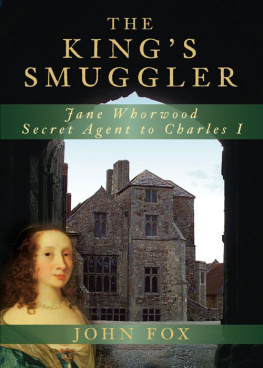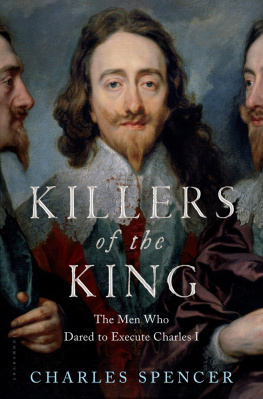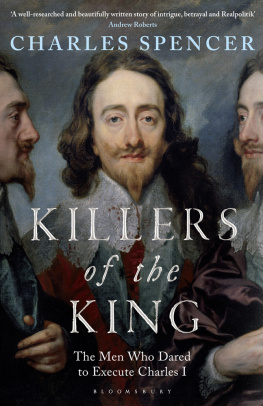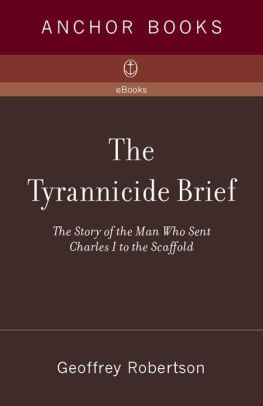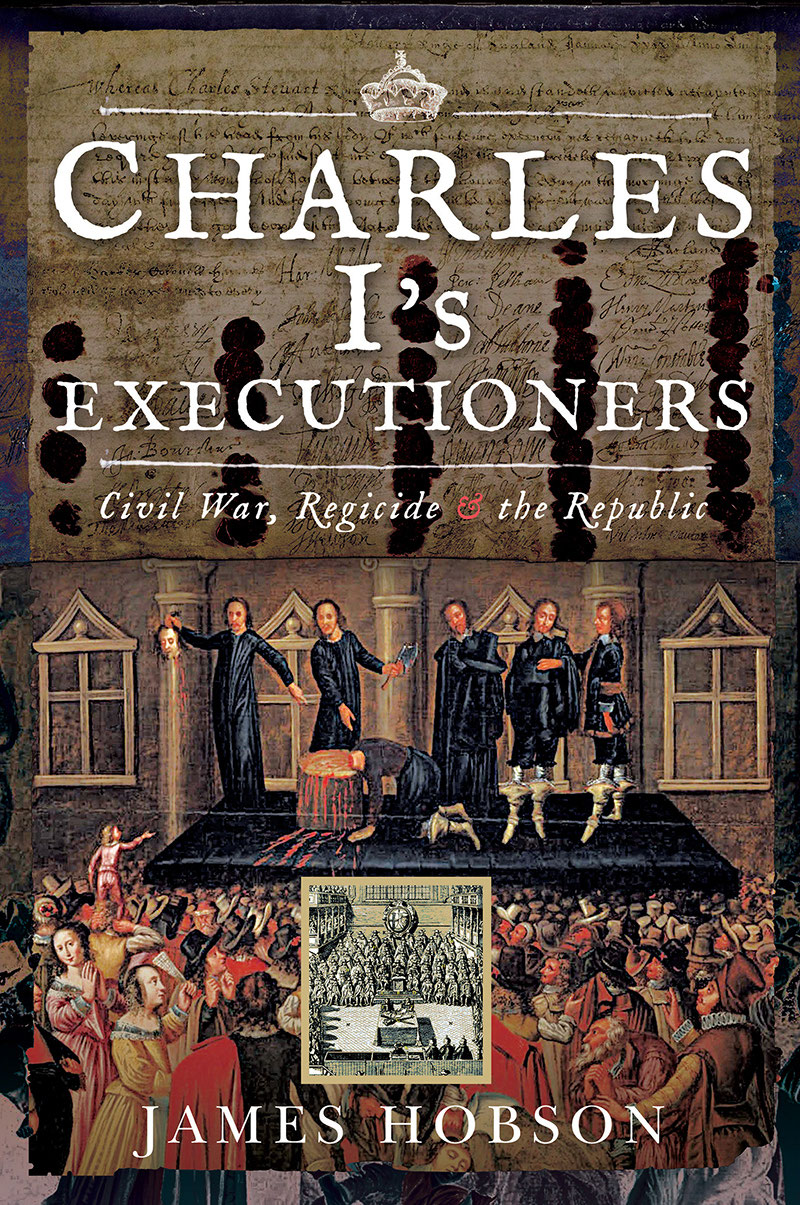CHARLES Is EXECUTIONERS
CHARLES Is EXECUTIONERS
CIVIL WAR, REGICIDE AND THE REPUBLIC
JAMES HOBSON
First published in Great Britain in 2020 by
PEN AND SWORD HISTORY
An imprint of
Pen & Sword Books Ltd
Yorkshire Philadelphia
Copyright James Hobson, 2020
ISBN 978 1 52676 184 2
eISBN 978 1 52676 185 9
Mobi ISBN 978 1 52676 186 6
The right of James Hobson to be identified as Author of this work has been asserted by him in accordance with the Copyright, Designs and Patents Act 1988.
A CIP catalogue record for this book is available from the British Library.
All rights reserved. No part of this book may be reproduced or transmitted in any form or by any means, electronic or mechanical including photocopying, recording or by any information storage and retrieval system, without permission from the Publisher in writing.
Pen & Sword Books Limited incorporates the imprints of Atlas, Archaeology, Aviation, Discovery, Family History, Fiction, History, Maritime, Military, Military Classics, Politics, Select, Transport, True Crime, Air World, Frontline Publishing, Leo Cooper, Remember When, Seaforth Publishing, The Praetorian Press, Wharncliffe Local History, Wharncliffe Transport, Wharncliffe True Crime and White Owl.
For a complete list of Pen & Sword titles please contact
PEN & SWORD BOOKS LIMITED
47 Church Street, Barnsley, South Yorkshire, S70 2AS, England
E-mail: enquiries@pen-and-sword.co.uk
Website: www.pen-and-sword.co.uk
Or
PEN AND SWORD BOOKS
1950 Lawrence Rd, Havertown, PA 19083, USA
E-mail: Uspen-and-sword@casematepublishers.com
Contents
Introduction
How many names on a piece of paper are needed to execute your king? The answer in January 1649 was fifty-nine. Their signatures and seals were affixed to a piece of parchment, with each subsequent column of names more crammed in than the last, yet with space left unused in the last column. Why would they leave a space and arrange the signatures to allow more?
So, even the arrangement is an enigma. Did they want more names, or did they feel that they had enough? It was certainly enough to behead Charles I and set up a government without a monarch for the first and last time in British history. Some people today have cast doubt on the use of the word revolution to characterise the events of the civil war, but how else would you describe the trial and execution of the king and the abolition of the monarchy and House of Lords in a period of six months in 1649?
Who were the fifty-nine men who started this process? In short, they were puritans, politicians, soldiers, lawyers, bureaucrats and merchants. Some were opportunists, some were cowards, some were filled with spite and personal ambition, while others sacrificed themselves for a cause that dominated their lives. Some men acted on the noblest motivations of political and religious duty, inspired by a deep and intensive examination of their conscience, while others were greedy, weak, cynical and superficial. Most were army officers or MPs, or both. Some of them have claimed their place in British history, but the majority a clear majority remain completely unknown, and seem to merit no more than passing mentions in even the most comprehensive histories of the civil war.
This book is based on the belief that each regicide can tell us something important about the English Civil War and its aftermath. None of these men deserve to be footnotes, or called deedless, as some Victorian historians claimed. Committing regicide is the greatest of political statements. These fifty-nine organised and supported the only coup dtat in British history, and the only judicial execution of a monarch. The document they signed is not a work of fiction or the result of coercion. Indeed, lack of coercion was a more obvious characteristic. They had plenty of opportunities to shrink away from the ultimate act, and to do so without any risk to themselves. They may have been a very mixed bunch, but their determination to see events through makes them a cohort worth studying, both as individuals and in groups of like-minded people.
The fact that regicide was not unprecedented does not detract from the historical significance of the event. Sometimes monarchs are killed by their own people, sometimes in their own country, in public view and with a form of judicial process; but all these things happening at the same time creates a unique event. The 1649 execution was a transparent act, done with righteousness and at least the facade of confidence. Charles was never deposed; he was the lawful king until the end. The last words he would have heard were Your Majesty, and they came from a plebeian headsman.
There were 135 High Commissioners selected by the Parliament and army leaders, of which about seventy took an active part in the trial, and only fifty-nine signed the death warrant. Those who refused to take part were not punished, although there was some psychological pressure applied while signatures were being collected. After the restoration, individuals made their excuses; threats of violence were part of their mitigation, but, as the book will show, there was not much substance to it. The execution warrant was largely signed by people who, at the time, wished to sign it. Their level of determination, their motives and the strength of their feeling, however, varied considerably.
Each name, even those that have been forgotten, represents another reason why the king was executed. It is true that this book tries to treat them more equally than they deserve in order to establish why they would have wished to be remembered as regicides. The plan is to find at least one interesting thing about each of them which can help answer the question: why did it happen?
This is not a book of mini-biographies. Such a book would not only repeat itself tediously but would also fail to get over some of the common characteristics between the men that help to explain events. A biography, no matter how thin, would not be possible for many of the regicides. The evidence is often scarce and tainted by the centuries of hatred and resentment. Information about character and personality is rare and not always reliable; but it has been pounced on when it is available. Because of the available sources, this is a book about men. Women mattered in the civil war, however, and the absence of evidence is not evidence of absence. Where women made a difference, their story has been told, if it was known.
Some regicides are so pivotal that they have their own chapter, but they are mostly grouped based on their shared characteristics. Pains have been taken to make the groupings work, but they are never one hundred per cent convincing. Some apparent groupings turned out to be illusions. For example, there were six Sussex regicides, but there was nothing about Sussex that united them, apart from their Puritanism. A group consisting of Puritans would have fifty-plus members. That Sussex was more Puritan than most was not a categorisation that shone any light on their motivations and actions. Buckinghamshire was another Puritan county but their regicides could not hang together in the same group, despite the fact that they lived close together and were members of the same extended families.
The book uses the word regicide in the strict sense, referring to those who signed the death warrant. This is not the approach taken by most historians today or by most people at the time. When the monarchy was restored in 1660, eighty, not fifty- nine, were exempted from pardon, and among those additional names were men like Hugh Peters, a firebrand Puritan preacher, John Cook, a republican lawyer and Daniel Axtell and Francis Hacker, who organised the security for the trial and execution. They are mentioned only briefly in this book, but strictly speaking deserve the title of regicide more than many who signed the warrant.

